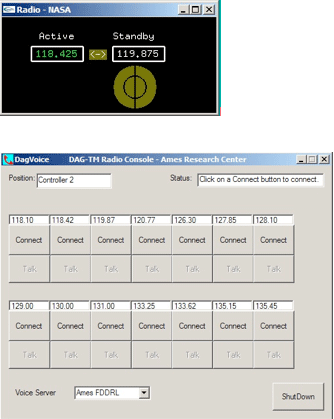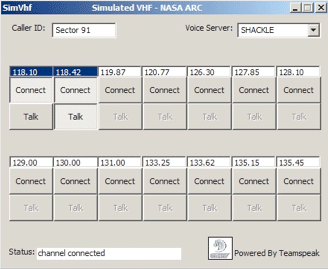|
|
 |

|
 |
 |
The Flight Deck Research Group's voice over IP capability was originally conceived and built to support the group's Distributed Air/Ground - Traffic Management (DAG-TM) work. The resulting application, DagVoice, is a tested and proven solution for providing flight simulation voice communications between Air Traffic Controllers and pilots - study participants and support personnel alike - located anywhere internet access is available.
Implementing Voice Over IP in the Distributed Air/Ground - Traffic Management (DAG-TM) Efforts
In 2002 the analog technology providing real-time DAG-TM flight simulation communications at NASA Ames became obsolete. With participants needing to enter flight simulation studies remotely, via the internet, a reliable, multi-channel communication tool was needed. A first of its kind VoIP application, DagVoice was developed in-house in 2002, and was specifically built to provide multi-channel, multi-cast capability. DagVoice has been used in many of our distributed simulations, providing voice communication to our experiment participants across the country. Sometimes over 100 simultaneous users.
DagVoice
Key functionality of the DagVoice voice system are as follows:
- 14 channel / 50 user per channel capacity
- Half duplex or full duplex operation (monitoring or transmit-and-monitor)
- Pilot-to-Pilot air-side-only 'private' channels
- Controller-to-Controller ground-side-only 'private' channels
- Multi-channel monitoring and recording - Multi-channel broadcasting
- Push-to-talk
|
Below are images of the radio user interface for pilots and controllers, respectively.

SimVhf - our second generation multi-channel, multi-cast voice system
The newest VoIP system, SimVhf was built in 2011 to provide compatibility for Windows 7 operating systems and beyond. SimVhf was built based on the Teamspeak SDK, and is decoupled from Microsoft's DirectX runtime environment. While boasting the same capabilities as its predecessor (DagVoice), SimVhf provides superior voice quality as well as 30% reduction in latency. Encryption can also be implemented, if the requirement is needed.
 |
|
|